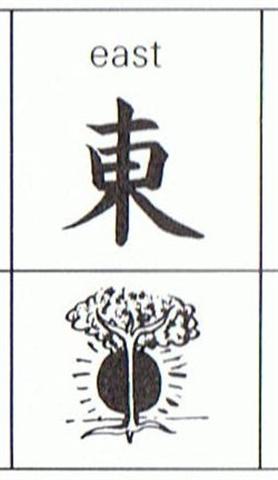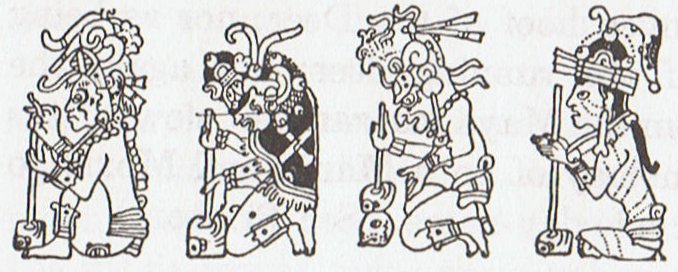Rogo in Kb1-8 will evidently start to move (come alive) in the interval to Kb1-12, at least there is a change to looking ahead. Normally a Rogo type of glyph is drawn en face, looking towards us with both his 'eyes' (mata), but in Kb1-8 there is no eye at left, presumably because before September 1 there is only darkness:
The drilled hole perforating both line b1 and b2 could be a Sign of drilling a new fire. Either it was there already before the creator of the K text began his work or he created the hole himself. The fire plough was the standard implement for creating fire in Polynesia and the fire drill could therefore have been used for special purposes. ... Before the events that are related in this story Mahuika alone possessed the gift of fire, and all fire in the world was got from her. After Maui had tricked her, fire was kept in the wood of certain trees, from which men were able to release it ... ... Even Mahuika herself almost perished before she could reach her place of shelter, and her shrieks were as loud as those of Maui when he was scorched. The waters rose all around her, and in this way Mahuika was deprived of her former power. But fire was saved for the world. When the waters reached her tikitiki, or the topknot of her head, the last seeds of fire fled from it to the rata , the hinau, the kahikatea, the rimu, and certain other trees. These trees would not admit them, and so they went to the mahoe, the totara, the patete, the pukatea, and the kaikomako, where they were cherished. These are the trees from whose dry wood fire can be obtained by friction. The others are of no use for this purpose ... On Easter Island spring arrives in September, and we can compare with how north of the equator January and February belong in winter and March brings spring. These 2 months are comparable to July and August. To create fire man needs wood. Inside certain kinds of wood there is fire and it can be brought out through hard work. In Kb1-10 there are hatchmarks which mean, I suggest, 'fire inside'. The henua type of glyph probably illustrates wood (a tree trunk). "He [Eric Thompson] established that one sign, very common in the [Mayan] codices where it appears affixed to main signs, can be read as 'te' or 'che', 'tree' or 'wood', and as a numerical classifier in counts of periods of time, such as years, months, or days. In Yucatec, you cannot for instance say 'ox haab' for 'three years', but must say 'ox-te haab', 'three-te years'. In modern dictionaries 'te' also means 'tree', and this other meaning for the sign was confirmed when Thompson found it in compounds accompanying pictures of trees in the Dresden Codex." (Michael D. Coe, Breaking the Maya Code.) When light returns to nature in spring it ought to mean someone has brought out fire from its abode in some wood. Spring ('dawn) can therefore be illustrated by a tree (or rather the stem of a tree): " "Usually explained incorrectly as sun rising behind trees to indicate dawn and thus east, an error of many centuries' standing. Very old forms reveal that is is a tied sack with a pole thrust through to facilitate carrying, and in that regard it is in the same group as bundle and select / open bundle ... The error seems to stem from a reasonably early form in which the ends of the binding have become separated from the sack, thus suggesting the early form of tree / wood. It is not clear whether this is a simple copying error, an attempt to refer to the wooden nature of the pole, or a mistaken interpretation of the elements as sun and tree. In any event, from an early stage [it] was borrowed phonetically to express east. Some scholars feel that it also lent an idea of thrusting through (i.e. the pole through the binding) and thus by extension suggested the sun thrusting up through the horizon, giving dawn and hence east." (Kenneth G. Henshall, A Guide to Remembering Japanese Characters .) From there the development would go on to see also other seasons as trees. A tree illustrating winter, for instance, would be a type like rimu which would not admit fire inside. There is a connection between trees and seasons. And the place for fire drilling is at the 'grasping hand' at the horizon in the west:
"The manik, with the tzab, or serpent's rattles as prefix, runs across Madrid tz. 22 , the figures in the pictures all holding the rattle; it runs across the hunting scenes of Madrid tz. 61, 62, and finally appears in all four clauses of tz. 175, the so-called 'baptism' tzolkin. It seems impossible, with all this, to avoid assigning the value of grasping or receiving. But in the final confirmation, we have the direct evidence of the signs for East and West. For the East we have the glyph Ahau-Kin, the Lord Sun, the Lord of Day; for the West we have Manik-Kin, exactly corresponding to the term Chikin, the biting or eating of the Sun, seizing it in the mouth." (William Gates, An Outline Dictionary of Maya Glyphs.)
The first 4 pictures show east, north, west, and south. The lower two glyphs represent 'Lord' (Ahau) and 'grasp' (Manik). Manik was the 7th day sign of 20 such and Ahau was the last of them. According to the Mayan view above it evidently was necessary to involve 4 persons to change the state of 'cloth', to raise the 4-cornered 'earth'. |







